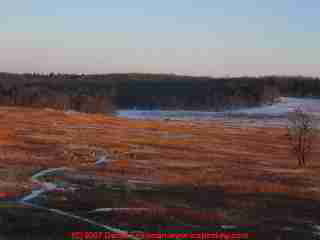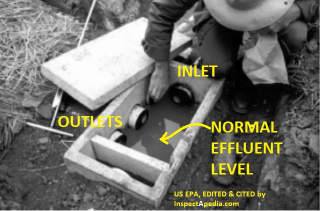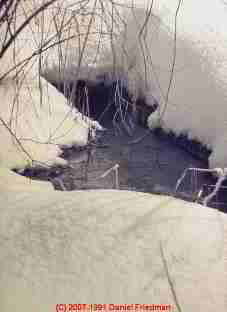 Why do We Need to Locate the Septic Drainfield?
Why do We Need to Locate the Septic Drainfield?
Find the drainfield, seepage beds, leachfield, or soakbeds
- POST a QUESTION or COMMENT about why and when we need to find the septic system drainfield or soakaway beds
Why do we care where the septic drainfield is located?
What can we do about finding the drainfield, seepage beds, leachfield, or soakbeds? This article and our accompanying septic system location videos explains how to find the leach field or drainfield portion of a septic system.
We include sketches and photos that help you learn what to look for, and we describe several methods useful for finding buried drainfield components. (Septic drain fields are also called soil absorption systems or seepage beds.)
InspectAPedia tolerates no conflicts of interest. We have no relationship with advertisers, products, or services discussed at this website.
- Daniel Friedman, Publisher/Editor/Author - See WHO ARE WE?
Guide to Finding the Drainfield - Part 2
Why Look For the Drainfield? How to Find the Septic Fields
Site planning requires septic drainfield location
"How do I find my septic system's drainfield?"
is a question we hear often. There are several reasons that you may need to know the accurate location of the leachfield or drainfield.
Planning new site construction or house additions:
If you are
planning to install a pool, deck, or to do any work that involves driving across your
property you want to keep these activities off of the drainfield, also called leach field which has the
job of treating and disposing of effluent from the septic tank.
Planning site landscaping around the septic system:
Other reasons for locating the leach field include septic system care such as keeping plants, particularly trees, away from this component lest roots clog it and lead to a septic system failure.
If your septic area is as overgrown as that shown in this photo, you can assume that it is unlikely to be functional.
See Planting Over Septic Systems for advice about what you should and should not plant over or near a septic system leachfield or drainfield to protect and not harm its operation.
Septic System Maintenance Requires Knowing Drainfield and D-Box Locations

Maintaining the septic system:
if you know where all of the septic components are, you can investigate their condition and perform maintenance.
For example some systems are designed to permit adjustment of effluent flow among different drainfield sections, allowing sections to rest and recover.
In the US EPA photograph at left the technician is adjusting a concentric opening cap on individual drainfield lines to balance effluent flow among them.
Diagnosing septic system failures requires knowing septic drainfield location

Diagnosing septic backups, slow drains, or wet areas:
if you know where the D-box (distribution box) and where the septic drainfield individual leach lines or seepage pits are located, you can explain possible wet areas as either probably harmless (distant from any known septic components), harmful (flooding the septic fields), or indicative of septic field failure (odors and effluent appearing at ground surface).
When we found this wet area showing up under deep snow cover at the rear of a residential property we had to decide if it was groundwater, a local spring, or a failing septic system. It was pretty smelly which made everyone suspicious.
The worst turned out to be true.
We had a septic drainfield that had been installed in soil with high seasonal water table, lots of local groundwater and surface runoff from nearby Clover Hill in Poughkeepsie, NY, inadequate fill in the drainfield area, a failed steel septic tank, and a failed drainfield.
Total replacement of the drainfield included a curtain drain to intercept local groundwater, site drainage corrections, additional fill for the drainfield area, and a new tank and drainfield system.
Curtain drains or intercept drains can protect septic drainfields in areas of wet soils or surface and subsurface groundwater
...
Continue reading at RECORDS to LOCATE the DRAINFIELD or select a topic from the closely-related articles below, or see the complete ARTICLE INDEX.
Or see these
Recommended Articles
- ODORS, SEPTIC or SEWER
- SEPTIC COMPONENT LOCATIONS
- SEPTIC DRAINFIELD INSPECTION & TEST - home
- SEPTIC DRAINFIELD LOCATION
Suggested citation for this web page
REASONS to FIND THE DRAINFIELD at InspectApedia.com - online encyclopedia of building & environmental inspection, testing, diagnosis, repair, & problem prevention advice.
Or see this
INDEX to RELATED ARTICLES: ARTICLE INDEX to SEPTIC SYSTEMS
Or use the SEARCH BOX found below to Ask a Question or Search InspectApedia
Ask a Question or Search InspectApedia
Try the search box just below, or if you prefer, post a question or comment in the Comments box below and we will respond promptly.
Search the InspectApedia website
Note: appearance of your Comment below may be delayed: if your comment contains an image, photograph, web link, or text that looks to the software as if it might be a web link, your posting will appear after it has been approved by a moderator. Apologies for the delay.
Only one image can be added per comment but you can post as many comments, and therefore images, as you like.
You will not receive a notification when a response to your question has been posted.
Please bookmark this page to make it easy for you to check back for our response.
IF above you see "Comment Form is loading comments..." then COMMENT BOX - countable.ca / bawkbox.com IS NOT WORKING.
In any case you are welcome to send an email directly to us at InspectApedia.com at editor@inspectApedia.com
We'll reply to you directly. Please help us help you by noting, in your email, the URL of the InspectApedia page where you wanted to comment.
Citations & References
In addition to any citations in the article above, a full list is available on request.
- New York State Department of Health, APPENDIX 75-A WASTEWATER TREATMENT STANDARDS - INDIVIDUAL HOUSEHOLD SYSTEMS , [PDF] New York State Department of Health, 3 February 2010, retrieved 3/1/2010, original source: https://www.health.ny.gov/regulations/nycrr/title_10/part_75/appendix_75-a.htm
- Percolation Testing Manual, CNMI Division of Environmental Quality, Gualo Rai, Saipan provides an excellent English Language manual guide for soil percolation testing. Original source: www.deq.gov.mp/artdoc/Sec6art108ID255.pdf
- Soil Test Pit Preparation, fact sheet, Oregon DEQ Department of Environmental Quality, original source www.deq.state.or.us/wq/pubs/factsheets/onsite/testpitprep.pdf The Oregon DEQ onsite water quality program can be contacted at 811 South Ave, Portland OR 97204, 800-452-4011 or see http://www.oregon.gov/DEQ/
- Thanks to reader Michael Roth for technical link editing 6/29/09.
- SEPTIC TANK/SOIL-ABSORPTION SYSTEMS: HOW TO OPERATE & MAINTAIN [PDF] - , Equipment Tips, U.S. Department of Agriculture, 8271 1302, 7100 Engineering, 2300 Recreation, September 1982, web search 08/28/2010, original source: http://www.fs.fed.us/t-d/pubs/pdfimage/82711302.pdf.
- Pennsylvania State Fact Sheets relating to domestic wastewater treatment systems include
- Pennsylvania State Wastewater Treatment Fact Sheet SW-161, Septic System Failure: Diagnosis and Treatment
- Pennsylvania State Wastewater Treatment Fact Sheet SW-162, The Soil Media and the Percolation Test
- Pennsylvania State Wastewater Treatment Fact Sheet SW-l64, Mound Systems for Wastewater Treatment
- Pennsylvania State Wastewater Treatment Fact Sheet SW-165, Septic Tank-Soil Absorption Systems
- Document Sources used for this web page include but are not limited to: Agricultural Fact Sheet #SW-161 "Septic Tank Pumping," by Paul D. Robillard and Kelli S. Martin. Penn State College of Agriculture - Cooperative Extension, edited and annotated by Dan Friedman (Thanks: to Bob Mackey for proofreading the original source material.
- Advanced Onsite Wastewater Systems Technologies, Anish R. Jantrania, Mark A. Gross. Anish Jantrania, Ph.D., P.E., M.B.A., is a Consulting Engineer, in Mechanicsville VA, 804-550-0389 (2006). Outstanding technical reference especially on alternative septic system design alternatives. Written for designers and engineers, this book is not at all easy going for homeowners but is a text I recommend for professionals--DF.
- Builder's Guide to Wells and Septic Systems, Woodson, R. Dodge: $ 24.95; MCGRAW HILL B; TP; Quoting from Amazon's description: For the homebuilder, one mistake in estimating or installing wells and septic systems can cost thousands of dollars. This comprehensive guide filled with case studies can prevent that. Master plumber R. Dodge Woodson packs this reader-friendly guide with guidance and information, including details on new techniques and materials that can economize and expedite jobs and advice on how to avoid mistakes in both estimating and construction. Chapters cover virtually every aspect of wells and septic systems, including on-site evaluations; site limitations; bidding; soil studies, septic designs, and code-related issues; drilled and dug wells, gravel and pipe, chamber-type, and gravity septic systems; pump stations; common problems with well installation; and remedies for poor septic situations. Woodson also discusses ways to increase profits by avoiding cost overruns.
- In addition to citations & references found in this article, see the research citations given at the end of the related articles found at our suggested
CONTINUE READING or RECOMMENDED ARTICLES.
- Carson, Dunlop & Associates Ltd., 120 Carlton Street Suite 407, Toronto ON M5A 4K2. Tel: (416) 964-9415 1-800-268-7070 Email: info@carsondunlop.com. Alan Carson is a past president of ASHI, the American Society of Home Inspectors.
Thanks to Alan Carson and Bob Dunlop, for permission for InspectAPedia to use text excerpts from The HOME REFERENCE BOOK - the Encyclopedia of Homes and to use illustrations from The ILLUSTRATED HOME .
Carson Dunlop Associates provides extensive home inspection education and report writing material. In gratitude we provide links to tsome Carson Dunlop Associates products and services.


